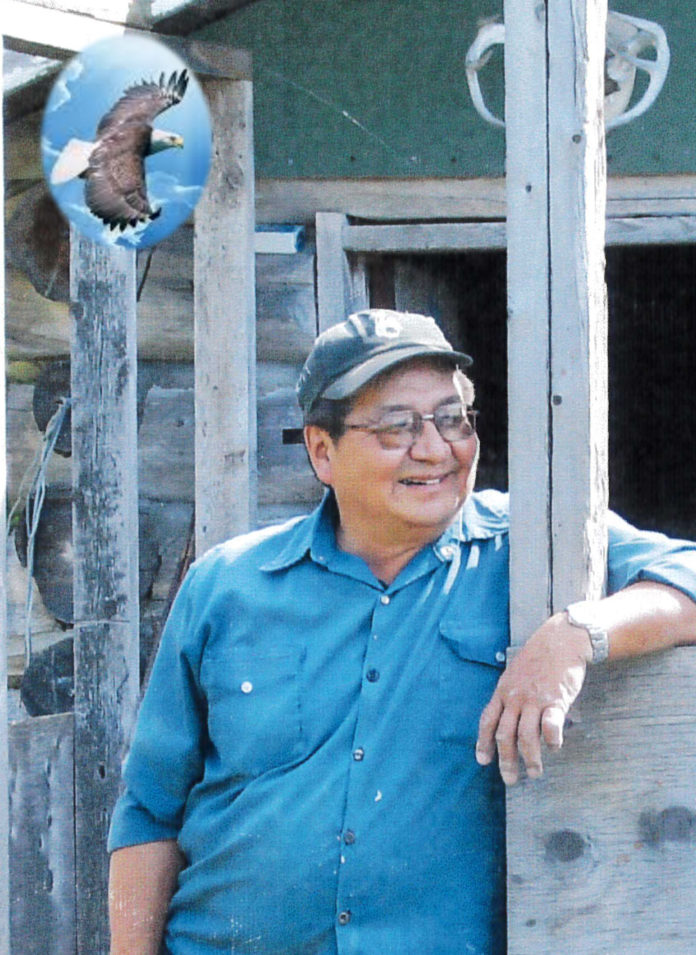MANITOWANING – Approximately 200 students from the Wiikwemkoong Board of Education rolled up their sleeves and tucked into work on rehabilitating Smith’s Bay Creek, a stream which runs through the community, past schools and the powwow grounds to empty into the bay. The students’ efforts complemented the work being done by Manitoulin Streams’ contractors, who laid down the base upon which the bushes, trees and shrubs were planted. Manitoulin Streams, an award-winning conservation program that works with private landowners across the Island to rehabilitate streams and assist those waterways, and the innumerable species they harbour within their banks, in recovery from nigh onto a century of interaction with less than ideal land use practices.
Anyone who has observed the work of Manitoulin Streams over the past several years can attest to the remarkable speed with which those streams are transformed from marine wastelands into vibrant and near pristine waters teeming with fry. The impact that work has had on the fisheries in the Island’s big waters has been tremendously positive.
Students participating in the work included Ms. Trudeau’s Grade 3, Ms. Payette’s Grade 2 and Ms. Manitowabi’s Kindergarten classes from the Junior School; Ms. Wemigwans’ Grade 4, Ms. Pulkkinen’s Grade 4, Ms. Parrington’s Grade 6, Mr. Ominika’s Grade 6, Ms. Leeson’s Grade 8 and Ms. Clarke’s Grade 8 from Wiikwemkoong Pontiac School; and Mr. Rampersad’s Grade 9 science, Mr. Mara’s Grade 9 math and Mr. Recollet’s Green Technologies classes from Wiikwemkoong High School.
“It all fell into place, all the partnerships on the reserve came into being,” said lands-based learning instructor Nimkii Lavell. “Most importantly, the kids totally bought into it. I believe that they have reconnected with the land.”
Mr. Lavell’s program seeks to bring students back into contact with the land, as it is the land from which the traditions and culture of the Anishinaabe has sprung. There is a huge difference between seeing something in photographs and videos and the tactile experience of actually being in nature he pointed out. “It’s something that is really remarkable to see happening first hand,” he said. “It’s empowering for everyone involved.”
“Manitoulin Streams, in partnership with Wiikwemkoong Unceded Territory (the Lands, Tourism and Board of Education departments), are working on Smith Bay Creek to restore 123 metres by 1.5 metres (that’s 184.5 square metres) of in-stream habitat using bio-engineering techniques to reduce erosion and prevent sedimentation from occurring over critical spawning habitats,” shared Manitoulin Streams program manager Seija Deschenes. “They planted 300 native trees and 300 shrubs and 100 milkweed plants to restore 123 metres by three metres on both sides, creating 738 square metres of riparian habitat to trap and absorb nutrients and rainwater runoff and reduce climate change impacts to stream temperatures.” The students also helped conduct a garbage cleanup over the 4,602 square metres of stream watershed to remove plastics from entering their stream and affecting water quality. Finally, the project aimed to remove invasive phragmites at the mouth of the creek to help migrating salmonids access the spawning grounds and to protect native species and the aquatic ecosystem.
“We had community involvement from a variety of interest groups including Wiikwemkoong Lands and Resources, Wiikwemkoong Tourism, Point Grondine park guardians, Manitoulin Streams members and school groups from Wasse-Aubin Junior, Pontiac and Wiikwemkoong high school,” she said. “Those organizations and volunteers helped contribute toward the completion of the project through in-kind support and resources.”

The collaboration between Manitoulin Streams and Wiikwemkoong Unceded Territory will see numerous benefits, noted Ms. Deschenes, including an improved fishery for food security and recreational and cultural tourism; cleaner and healthier water for the community and surrounding waters; adaptations to reduce climate change impacts and removal of invasive species impacting resources used for materials, medicinal purposes and cultural activities.
She pointed out that, “Smith Bay Creek is an essential creek to community members as it lies in the heart of their community. It flows beside their schools and is used for land-based learning and educational purposes; resides along the powwow grounds used for cultural ceremonies and used as a traditional harvesting area for food security,” she said. “Improvements could provide economic stimulus in regards cultural tourism (stream-side tours) and recreational angling and job opportunities.”
“Electro-fishing assessments in 2018 indicated 11 different species dominated by rainbow trout,” said Ms. Deschenes. “However, inconsistencies with the presence of some species throughout the creek indicate unsuitable habitats or impediments to migration, all factors which will be exacerbated by climate change.”
She pointed out that channelization between 1971-2016 caused habitat loss (lack of pools, riffles), erosion and sedimentation to flow into Lake Huron. “Concerns identified in the enhancement strategy include: debris removal due to recent wind burst that destroyed numerous older trees along the creek blocking the stream; bank erosion requiring regrading of slopes and stabilization; tree and shrub planting to help with climate change adaptation; pinch points that require widening of stream, stabilization and introduction of riffle-pool sequences to improve aquatic and fish spawning habitat; and garbage removal to reduce plastic pollution as this area is close to community centres and their cultural facilities.”
In addition, at the mouth of Smith Bay Creek, “There is invasive species phragmites that is replacing native vegetation and has the potential to block migratory salmonid species from accessing critical spawning areas and having an impact on traditional harvesting areas,” she said.
In planning the project, a hydrological/water resource engineer created site designs using “nature based solutions” and provided site supervision. All construction follows the instructions in the engineered tenders.
The bio-engineering techniques used included stabilizing the toe of stream banks with boulders, woody habitat, soil and bio-degradable coconut coir matting to prevent erosion and installing in-stream habitat (boulder clusters, pool and riffle areas, placement of spawning gravel). “Restoration will reduce the amount of sedimentation from re-occurring over prime spawning habitat; improve fish habitat (e.g. channel edges, channel center, width/depth ratios, pools and riffles, bottom substrate); reduce the effects of fluctuating water levels and rising water temperatures enhancing the overall quality and productivity of this river’s aquatic habitats and associated biota over the long term,” said Ms. Deschenes. “Riparian vegetative buffers will trap and absorb nutrients and rainwater runoff before it enters the stream; stabilize banks; reduce soil erosion and sedimentation; prevent potentially damaging floods; provide habitat corridors for wildlife; and provide shade to help reduce climate change effects that increase water temperatures as well as optimize Wiikwemkoong’ s re-greening initiative.”
Consultation with Wiikwemkoong’s Land and Resources department and elders helped identify trees, shrubs and plants that were traditionally and currently used for medicine, food, materials and cultural practices, said Ms. Deschenes, noting that thanks to the work being done, “they will be protected or re-established along this stream watershed. Community members and school groups helped with native tree and shrub planting and a garbage cleanup to reduce plastics from entering Lake Huron improving water quality and community health. Manitoulin Streams removed invasive species phragmites from impacting aquatic biota and fish migration at the mouth of Smith Bay Creek.”





